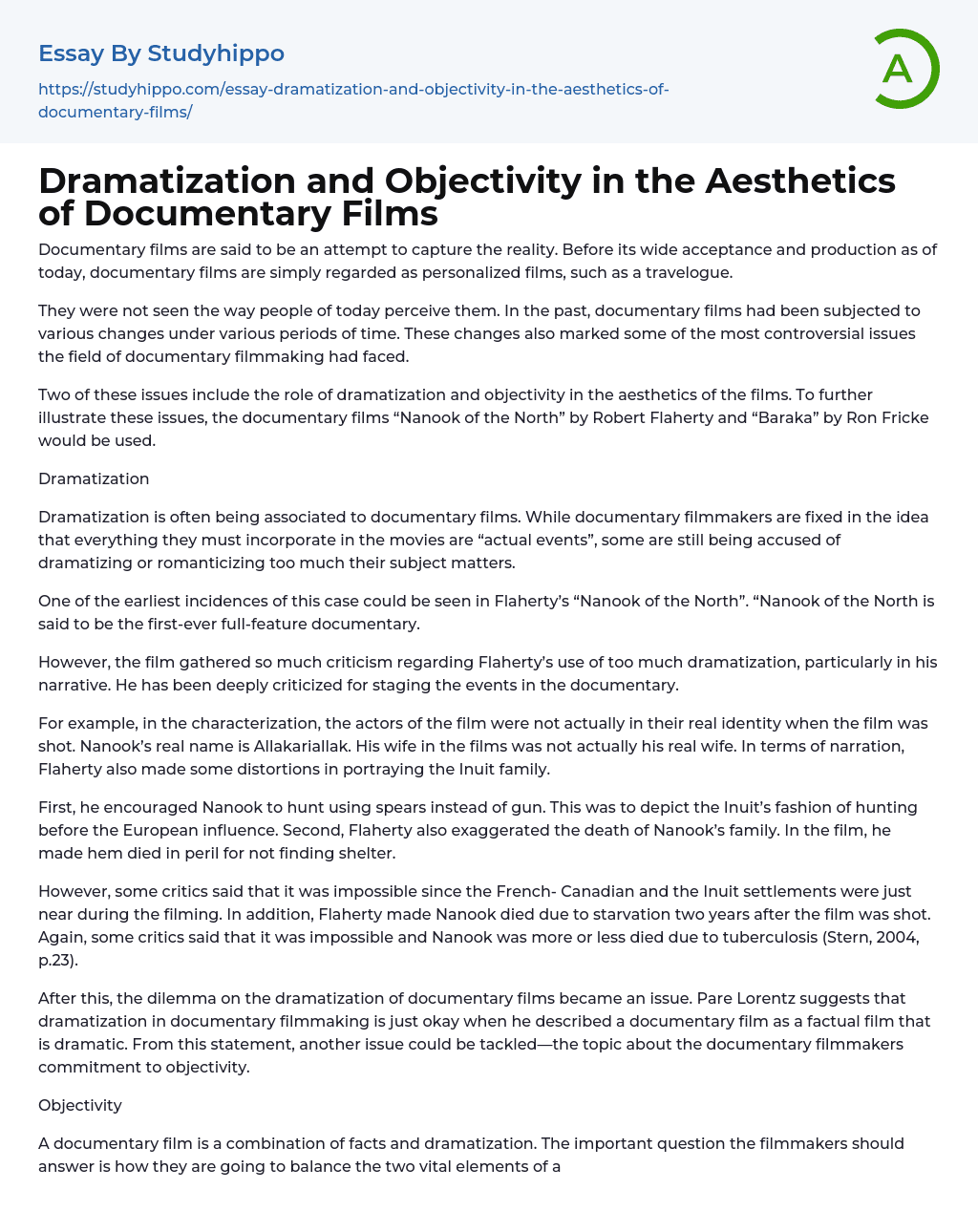

Dramatization and Objectivity in the Aesthetics of Documentary Films Essay Example
Documentary films are said to be an attempt to capture the reality. Before its wide acceptance and production as of today, documentary films are simply regarded as personalized films, such as a travelogue.
They were not seen the way people of today perceive them. In the past, documentary films had been subjected to various changes under various periods of time. These changes also marked some of the most controversial issues the field of documentary filmmaking had faced.
Two of these issues include the role of dramatization and objectivity in the aesthetics of the films. To further illustrate these issues, the documentary films “Nanook of the North” by Robert Flaherty and “Baraka” by Ron Fricke would be used.
Dramatization
Dramatization is often being associa
...ted to documentary films. While documentary filmmakers are fixed in the idea that everything they must incorporate in the movies are “actual events”, some are still being accused of dramatizing or romanticizing too much their subject matters.
One of the earliest incidences of this case could be seen in Flaherty’s “Nanook of the North”. “Nanook of the North is said to be the first-ever full-feature documentary.
However, the film gathered so much criticism regarding Flaherty’s use of too much dramatization, particularly in his narrative. He has been deeply criticized for staging the events in the documentary.
For example, in the characterization, the actors of the film were not actually in their real identity when the film was shot. Nanook’s real name is Allakariallak. His wife in the films was not actually his real wife. In terms of narration, Flaherty also made some
distortions in portraying the Inuit family.
First, he encouraged Nanook to hunt using spears instead of gun. This was to depict the Inuit’s fashion of hunting before the European influence. Second, Flaherty also exaggerated the death of Nanook’s family. In the film, he made hem died in peril for not finding shelter.
However, some critics said that it was impossible since the French- Canadian and the Inuit settlements were just near during the filming. In addition, Flaherty made Nanook died due to starvation two years after the film was shot. Again, some critics said that it was impossible and Nanook was more or less died due to tuberculosis (Stern, 2004, p.23).
After this, the dilemma on the dramatization of documentary films became an issue. Pare Lorentz suggests that dramatization in documentary filmmaking is just okay when he described a documentary film as a factual film that is dramatic. From this statement, another issue could be tackled—the topic about the documentary filmmakers commitment to objectivity.
Objectivity
A documentary film is a combination of facts and dramatization. The important question the filmmakers should answer is how they are going to balance the two vital elements of a documentary film. If it is purely factual, then the film is no longer a documentary but a mere scientific or factual video.
On the other hand, if the film employed too much dramatization, it is no longer a documentary but a drama film. Therefore, a good documentary filmmaker should infuse equally both facts and drama in his work. Such excellence in the combination of the two elements was seen in the documentary film “Baraka”
by Ron Fricke. The film is an experimental and purely visual that showcases the various landscapes and destinations in the world.
Although the film has no dialogue, dramatization was still achieved through the magnificent use of camera techniques and the creative skills of the director. Each of the scenes seems to have its own story to tell. In addition, “Baraka” also sticks to objectivity as all of the footages were based on facts.
From this, we could conclude that just like what Bill Nichols has said, “filmmaking practice, a cinematic tradition, and mode of reception” is continuously changing and evolving with no clear boundaries ( Nichols, 1997).
References
Flaherty, R. (1922). Nanook of the North. Internet Movie Database. Retrievd on 18 June
2008. http://www.imdb.com/title/tt0013427/
Fricke, R. (1992).Baraka. Internet Movie Database. Retrieved on 18 June 2008.
http://www.imdb.com/title/tt0103767/
Nichols, B. (1997). 'Foreword', in Barry Keith Grant and Jeannette Sloniowski (eds.)
Documenting The Documentary: Close Readings of Documentary Film and Video.
Detroit: Wayne State University Press
Stern, P.R. (2004). Historical Dictionary of the Inuit. Lanham, MD: Scarecrow Press, p. 23.
- Movies essays
- Music essays
- Celebrity essays
- Television essays
- Actors essays
- Roller coaster essays
- Magic essays
- Media essays
- Video Game essays
- Wall Street essays
- Dead Poets Society essays
- A beautiful mind essays
- Sherlock Holmes essays
- Our day out essays
- American Beauty essays
- Do The Right Thing essays
- Forrest Gump essays
- Good Will Hunting essays
- Finding Forrester essays
- Looking For Alibrandi essays
- On The Waterfront essays
- One Flew Over The Cuckoo'S Nest essays
- Rabbit Proof Fence essays
- Remember The Titans essays
- Schindler'S List essays
- Shawshank Redemption essays
- The Blind Side essays
- Titanic essays
- Witness essays
- The Veil essays
- Blade Runner essays
- Monster essays
- The Graduate essays
- Twilight essays
- West Side Story essays
- Like Water For Chocolate essays
- Glory essays
- Superman essays
- Moulin rouge essays
- American Films essays
- Cinema Of The United States essays
- English-Language Films essays
- Film Editing essays
- Film Noir essays
- Film Techniques essays
- Horror essays
- Bollywood essays
- The time essays
- Saving private ryan essays
- The hunger games essays



